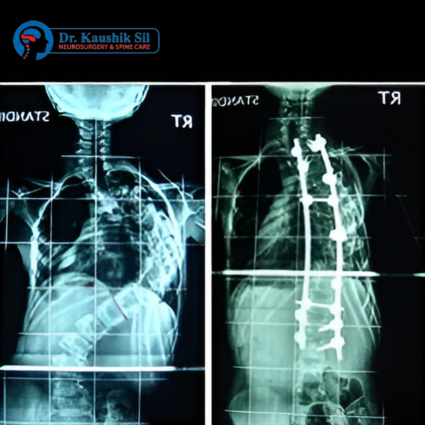Spine Surgery
Spine Surgery

Spinal problems are very common ailments especially in this jet- set age. Almost everyone suffers from some sort of back pain at some point of time. It is the commonest problem seen and treated by us on day to day basis. The spinal column consists of 33 small bones (vertebrae) united by a set of ligaments and held in its position by back muscles. It helps us to stand erect , transfers the body weight to the pelvis and provide cover to the spinal cord – the long stem like nervous column that carries nerves to all parts of the body from the brain Common spinal problems are –
- Low back pain – due to posture, occupation, weight gain, lack of exercise
- Disc prolapse – extrusion of disc (a jelly like substance in between the bony vertebra) presents as sharp pain in the hands or legs, weakness of fingers or toes, even difficulty in passing urine.
- Spondylolisthesis – slippage of one vertebra over other leads to a combination of back pain, leg pain and paralysis
- Spinal tumors – present with back pain, burning sensations, various degrees of paralysis
- Spinal trauma – injury to the spine may result in fracture of the vertebra
- Spinal deformities – like scoliosis which is usually by birth
Most of the spinal problems are relieved with postural corrections, exercise and physiotherapy regimen. Surgical interventions are needed in cases of persistent pain, muscle weakness and paralysis. Surgery of the spine is safe and efficacious. They do not carry the risk of paralysis except in very advanced cases. Depending on the pathology, the various surgeries range from microsurgery for disc prolapse to complex spinal instrumentations where the spinal deformities are corrected with rods and screws. Spinal surgery also involves lots of instruments like surgical microscope, portable X-rays, navigation guides and implants.
Case Study
A 16 year old boy was brought by his father with complaints of back pain, leg pain, and progressive difficulty in breathing. On examination the boy was found to have an acutely bend spine both in the sagittal and coronal planes ( kyphoscoliosis) . He also had a congenital defect in the vertebra and spinal cord which triggered this bending (split cord malformation). Dr. Sil operated him in a 6 hour long procedure to free his spinal cord (a machine called intraoperative neuromonitoring device was used at all times so that the patient do not develop paralysis) and also corrected the entire spine to a near normal shape (a cell saver was used to collect the patient’s own blood lost during operation and retransfuse it to the patient’s body thus avoiding hazards of donated blood transfusion). The boy recovered completely and in the process gained 5 inches of height.

